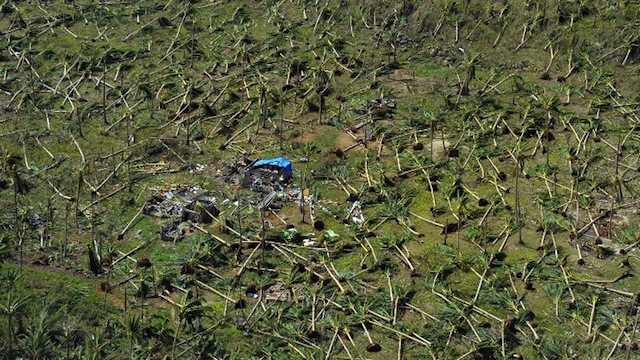SUMMARY
This is AI generated summarization, which may have errors. For context, always refer to the full article.

LEYTE, Philippines – The super typhoon that slammed through the central Philippines laid waste to a vast region of coconut farmland, eradicating in one fell swoop the livelihoods of tens of thousands of smallholders.
“It’s all gone,” Glen Mendoza said, gesturing towards the collection of snapped and toppled trees that used to be the small but reliable grove that fed and supported his family.
“My daughter might have to stop going to college,” he said. “These coconut trees are our only hope and now they’re gone.”
Mendoza’s plight is shared, not just by the farmers in his coconut-growing town of Burawin, but by tens of thousands of others across the island of Leyte.
A major coconut-growing province, Leyte accounts for one third of all the fruit produced in the fertile center of the country, according to the Philippine Coconut Authority (PCA).
The particular problem facing farmers like Mendoza is that there is no short-term solution to the loss of their groves.
Replanting can begin very soon but, depending on the variety, coconut trees take between 5 and 10 years to reach maturity and bear fruit.
More than 208,000 hectares (515,000 acres) are planted with over 22 million trees in Leyte, providing a living for 122,000 families, or around 600,000 people, said Joel Pilapil, a senior PCA official in the province.
There are no firm estimates yet on the full extent of the damage, but ground reports and aerial views of Leyte and nearby Samar island tell the same story – coconut trees either toppled, snapped or sheared when Typhoon Haiyan (Yolanda) scythed across the region on November 8, packing winds of up to 315 kilometres (195 miles) per hour.
“I’ve spent 21 years in the industry and this is the first time that the damage has been this heavy,” Pilapil told AFP in an interview at the PCA’s typhoon-damaged building in the town of Palo.
“It hurts… Coconut farming families are going to go hungry,” he said
(READ: Yolanda damage now at P9.46B)
Cipriano Alibay, 73, a farmer in Dagami town near Burawin, used to harvest 3,000 coconuts every 3 months from his now destroyed two-hectare smallholding.
“My investment is gone. I don’t know what to do,” he said.
According to Pilapil, the government is ready to provide free seedlings, but the ground must first be cleared of thousands of toppled trees, ruined buildings and other debris.
Trees that are still standing but have no hope of bearing fruit need to be cut down, he said, adding that the clearing operations could take months.
Watch coconut farmer Gilbert Negad from talk about the pests that hound coconut farms after being hit by super typhoon Yolanda (Haiyan) below.
Pilapil said some of the felled trees could provide timber for rebuilding houses destroyed by the typhoon.
As well as the farmers, many others relied on the coconut industry, including Rodolfo Ortega, 54, who buys dried coconut meat – called copra – from farmers and sells it to millers.
Copra extracts can be used in a variety of products, including soap and shampoo.
“It will probably take 10 years before coconut farmers can get on their feet,” Ortega told AFP as he and a few of his workers stood idly outside his warehouse in the town of Dagami.
He warned that with so many people dependent on the industry, the government must act fast to prevent social consequences.
“If people have no jobs, that can create social problems,” Ortega said, adding that the government should teach farmers to plant alternative crops while they wait for the seedlings to grow.
For coconut farmer Alibay, there is no choice but to keep going.
“We need to be strong in order to go on living,” he said. – Rappler.com
Add a comment
How does this make you feel?
There are no comments yet. Add your comment to start the conversation.